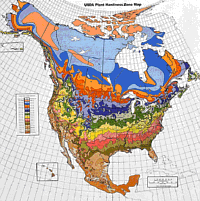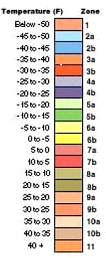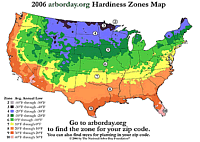|
|
| Rose Home > Growing Roses > Growing Zones |
Growing Zones
Get familiar with this map, and find your growing zone where you live. If you live outside North America, check out the zone maps at the bottom of this page When you grow roses in North America, this is one guide you can go by. Roses can be difficult to grow in some areas, but with the help of the USDA Map and information in this article you should be successful growing roses. This is the standard map that gardeners, growers, farmers, and ranchers go by. The USDA Map covers the average minimum winter temperatures per zone. There are 11 zones in North America, zones 1-11. When your purchasing a rose, you can use this for a basic guide to help in choosing your roses for your zone. Of course there are other factors that determine if a rose bush survives in your garden or not. The growing zone guide is just the start and will help you choose roses that are hardy to your zone. You must also have all the other basic requirements for growing roses. A minimum of 6-hours or more of sunlight daily, out of strong winds, proper hole and planting, the correct fertilizer to amend the soil to help the rose fill out to it's potential, adequate watering, pruning, and spraying at the correct times. There are also different environmental factors that effect rose growing, including wind, humidity, rainfall, temperature, and soil all influence growing roses. Remember the growing zones map is a basic good guide to start with. You can also have a microclimate in your yard that will let you grow a rose that is not rated for your area. A microclimate is a local atmospheric growing zone where the climate differs from the area it surrounds. This can be a several feet or miles long. If you find you can grow things in your garden that are not supposed to grow there, you may be in such a zone, and it can be wonderful for roses. I have a microclimate in my yard, and although I'm in zones 3b-4a, I can grow plants as if in zone 6 (with proper winter protection). This might also work in reverse; you might have a microclimate zone that is colder than your area zone and you can not grow as many roses or other perennials as you would like. If you garden with roses and other perennials, you should experiment and see what works in your yard. Keep a detailed record of what grows in your yard and what zone it was rated for, this way you can find out just what your local microclimate is.
Now that you've looked over the USDA Map, there is another theory to consider in gardening with roses or any plants. Look over this new map from Arborday.org from "2006'. It factors in Global Warming theory and the corresponding growing zones changes. According to Globabl Warming theory, the Earth is warming up due to man's influence, and there has been a subtle shift in growing zones. If you find you can grow more than you used to, it might be from global warming and not just your microclimate. Keep in mind, however, there is not universal agreement on Global Warming. What appears to be Global Warming may only be part of a cycllical temperature pattern that cycles over many thousands of years. There simply isn't enough long term data to verify for sure at this point. I am not a scientist, but I have seen such changes in the area I live. How does this affect growing roses or other perennials? Only time will tell. You can follow whichever hardiness map you choose with good results, which is why I've offered both options. But even if you do not believe in Global Warming, temperatures have risen on average over the last century, so don't be affraid to test the limits by experimenting with plants not rated for your growing zone. It is the best way of finding your own microclimate zone, and roses that will thrive in it for years to come! Other Growing Zones:European growing zones Australian Hardiness Zones New Zealand South American Growing Zones China Ukraine Russia Africa Japan |



